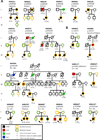RNF213 rare variants in an ethnically diverse population with Moyamoya disease
- PMID: 25278557
- PMCID: PMC4420622
- DOI: 10.1161/STROKEAHA.114.006244
RNF213 rare variants in an ethnically diverse population with Moyamoya disease
Abstract
Background and purpose: Moyamoya disease (MMD) is a rare, genetically heterogeneous cerebrovascular disease resulting from occlusion of the distal internal carotid arteries. A variant in the Ring Finger 213 gene (RNF213), altering arginine at position 4810 (p.R4810K), is associated with MMD in Asian populations. However, there are a lack of data on the role of RNF213 in patients with MMD of additional ethnicities and diasporic Asian populations. We investigate the contribution of RNF213 alterations to MMD in an ethnically diverse population based in the United States.
Methods: We initially sequenced RNF213 exons 43, 44, and 45 (encoding the eponymous RING finger domain) and exon 60 (encoding p.R4810K) in 86 ethnically diverse patients with MMD. Comprehensive exome sequencing data from 24 additional patients with MMD was then analyzed to identify RNF213 variants globally. Segregation of variants with MMD and other vascular diseases was assessed in families.
Results: RNF213 p.R4810K was identified in 56% (9/16) of patients with MMD of Asian descent and not in 94 patients of non-Asian descent. 3.6% (4/110) of patients had variants in the exons encoding the RING finger domain. Seven additional variants were identified in 29% (7/24) of patients with MMD who underwent exome sequencing. Segregation analysis supported an association with MMD for 2 variants and a lack of association with disease for 1 variant.
Conclusions: These results confirm that alterations in RNF213 predispose patients of diverse ethnicities to MMD, and that the p.R4810K variant predisposes individuals of Asian descent in the United States to MMD.
Keywords: RNF213 protein, human; moyamoya disease; stroke.
© 2014 American Heart Association, Inc.
Figures


References
-
- Scott RM, Smith ER. Moyamoya disease and moyamoya syndrome. N Engl J Med. 2009;360:1226–1237. - PubMed
-
- Kleinloog R, Regli L, Rinkel GJ, Klijn CJ. Regional differences in incidence and patient characteristics of moyamoya disease: a systematic review. J Neurol Neurosurg Psychiatry. 2012;83:531–536. - PubMed
-
- Wakai K, Tamakoshi A, Ikezaki K, Fukui M, Kawamura T, Aoki R, et al. Epidemiological features of moyamoya disease in Japan: findings from a nationwide survey. Clin Neurol Neurosurg. 1997;99:S1–S5. - PubMed
-
- Kuriyama S, Kusaka Y, Fujimura M, Wakai K, Tamakoshi A, Hashimoto S, et al. Prevalence and clinicoepidemiological features of moyamoya disease in Japan: findings from a nationwide epidemiological survey. Stroke. 2008;39:42–47. - PubMed
Publication types
MeSH terms
Substances
Grants and funding
LinkOut - more resources
Full Text Sources
Other Literature Sources
Medical
Molecular Biology Databases

